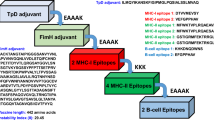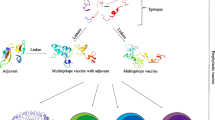Abstract
Melittin is a 26 amino acid amphipathic peptide, the main part of a bee venom. It has been confirmed that melittin can act against a vast verity of infectious agents, such as human immunodeficiency virus (HIV). This study aimed to investigate all physicochemical properties, post-modification sites, and interactions between melittin and HIV proteins. Ten Melittin sequences from different honey bees were collected from NCBI genebank. The physicochemical properties were evaluated for all sequences, and phosphorylation sites, glycolization positions and disulfide bonds were determined. Signal peptide was predicted by SignalP, secondary and tertiary structures were constructed by different software. Docking and interaction analysis were done by HEX and Discovery Studio. Results showed that most mutations occurred in Apis florae; this genotype was placed in a district clade in the cladogram. Physicochemical features showed melittin to be a basic protein and stable in prokaryotic and eukaryotic cells. It is an allergen peptide and no disulfide bonds and glycosylation site was found in its structure. Just one phosphorylation position was found and the majority of secondary structures are Alpha helix and Beta turn. High energy values of interactions belonged to capsid and protease proteins, and docking showed several amino acids to be involved in the interactions. Our observations suggested that in addition to envelope and long terminal repeat, capsid and proteases of HIV could have a great potential as a target for melittin. Our data provides a comprehensive understanding of melittin properties, structures, and its interaction with HIV proteins.



Similar content being viewed by others
Abbreviations
- HIV:
-
Human immunodeficiency virus
- LTR:
-
Long terminal repeat
- AIDS:
-
Acquired immunodeficiency syndrome
- NRTIs:
-
Nucleoside reverse transcriptase inhibitors
- NtRTIs:
-
Nucleotide reverse transcriptase inhibitors
- PIs:
-
Protease Inhibitors
- GRAVY:
-
Grand average of hydropath
References
Behzad D et al (2019) Interaction of human herpesvirus 8 viral interleukin-6 with human interleukin- 6 receptor using in silico approach: the potential role in HHV-8 pathogenesis. Curr Proteom 16:1–10
Benkert P et al (2010) Toward the estimation of the absolute quality of individual protein structure models. Bioinformatics 27(3):343–350
Blom N et al (1999) Sequence and structure-based prediction of eukaryotic protein phosphorylation sites. J Mol Biol 294(5):1351–1362
Carnathan DG et al (2015) Activated CD4+ CCR5+ T cells in the rectum predict increased SIV acquisition in SIVGag/Tat-vaccinated rhesus macaques. Proc Natl Acad Sci 112(2):518–523
Chauhan JS et al (2013) In silico platform for prediction of N-, O-and C-glycosites in eukaryotic protein sequences. PLoS ONE 8(6):e67008
Chen CH et al (2014) Absorption and folding of melittin onto lipid bilayer membranes via unbiased atomic detail microsecond molecular dynamics simulation. Biochem Biophys Acta 1838(9):2243–2249
Chen C-C et al (2009) 2–v2: template-based protein structure prediction server. BMC Bioinform 10(1):366
Choi E et al (2016) First phase I human clinical trial of a killed whole-HIV-1 vaccine: demonstration of its safety and enhancement of anti-HIV antibody responses. Retrovirology 13(1):82
Cornara L et al (2017) Therapeutic properties of bioactive compounds from different honeybee products. Front Pharmacol 8:412
Danielsen EM, Hansen GH (2018) Impact of cell-penetrating peptides (CPPs) melittin and Hiv-1 Tat on the enterocyte brush border using a mucosal explant system. Biochem Biophys Acta 1860(8):1589–1599
Dehghani A et al (2017) HIV/AIDS knowledge and attitude among high school students in Shiraz, Iran in 2015. J Midwifery Reprod Health 5(2):897–903
Dehghani B et al (2017) Functional and structural characterization of ebola virus glycoprotein (1976–2015)—an in silico study. Int J Biomath 10(08):1750108
Dehghani B et al (2019a) Using immunoinformatics and structural approaches to design a novel HHV8 vaccine. Int J Pept Res Ther. https://doi.org/10.1007/s10989-019-09839-x
Dehghani B et al (2019b) Bioinformatics analysis of domain 1 of HCV-core protein: Iran. Int J Pept Res Ther. https://doi.org/10.1007/s10989-019-09838-y
Desai M et al (2012) Antiretroviral drugs: critical issues and recent advances. Indian J Pharmacol 44(3):288
Eade CR et al (2012) Mechanisms and modifications of naturally occurring host defense peptides for anti-HIV microbicide development. Curr HIV Res 10(1):61–72
Ebbensgaard A et al (2015) Comparative evaluation of the antimicrobial activity of different antimicrobial peptides against a range of pathogenic bacteria. PLoS ONE 10(12):e0144611
Ensign LM et al (2014) Nanoparticle-based drug delivery to the vagina: a review. J Controll Release 190:500–514
Epand RM (2016) Host defense peptides and their potential as therapeutic agents. Springer, Cham
Farhadi T et al (2015) Production of a novel multi-epitope vaccine based on outer membrane proteins of Klebsiella pneumoniae. Trends Pharm Sci 1(3):167–172
Ferrè F, Clote P (2006) DiANNA 1.1: an extension of the DiANNA web server for ternary cysteine classification. Nucleic Acids Res 34(suppl_2):W182–W185
Francis DH (1999) Mechanisms in the pathogenesis of enteric diseases 2. Springer, Boston
Galdiero S et al (2013) Peptide-lipid Interactions: experiments and applications. Int J Mol Sci 14(9):18758–18789
Gasteiger E et al (2005) Protein identification and analysis tools on the ExPASy server. Proteom Protoc Handb, Springer. https://doi.org/10.1385/1-59259-890-0:571
Geourjon C, Deleage G (1995) SOPMA: significant improvements in protein secondary structure prediction by consensus prediction from multiple alignments. Bioinformatics 11(6):681–684
Gupta RK (2014) Taxonomy and distribution of different honeybee species. In: Reybroeck W, Veen JW, Gupta A (eds) Beekeeping for poverty alleviation and livelihood security. Springer, Dordrecht, pp 63–103
Habermann E, Kowallek H (1970) Modifications of amino groups and tryptophan in melittin as an aid to recognition of structure-activity relationships. Hoppe-Seyler's Z Physiol Chem 351(7):884–890
Hammer S (2006) Nucleoside analogue reverse transcriptase inhibitor options: a re-examination of the class. Top HIV Med 14(4):140–143
Hashempour T et al (2019) Evaluating drug resistant mutations to HCV NS3 protease inhibitors in iranian Naïve patients. Int J Pept Res Ther. https://doi.org/10.1007/s10989-019-09957-6
Heinen TE, da Veiga ABG (2011) Arthropod venoms and cancer. Toxicon 57(4):497–511
Hima Bindu A, Naga Anusha P (2011) Adverse effects of highly active anti-retroviral therapy (HAART). J Antivir Antiretrovir 3:060–064
Hood JL et al (2013) Cytolytic nanoparticles attenuate HIV-1 infectivity. Antiviral Ther 18(1):95–103
Iakoucheva LM et al (2004) The importance of intrinsic disorder for protein phosphorylation. Acids Res 32(3):1037–1049
Ingole N et al (2013) Performance of immunological response in predicting virological failure. AIDS Res Hum Retroviruses 29(3):541–546
Jallouk AP et al (2014) Nanoparticle incorporation of melittin reduces sperm and vaginal epithelium cytotoxicity. PLoS ONE 9(4):e95411
Jenssen H et al (2006) Peptide antimicrobial agents. Clin Microbiol Rev 19(3):491–511
Kang CY, Gao Y (2017) Killed whole-HIV vaccine; employing a well established strategy for antiviral vaccines. AIDS Res Ther 14(1):47
Kang Z et al (2019) Peptide-based gene delivery vectors. J Mater Chem B 7(11):1824–1841
Kelley LA et al (2015) The Phyre2 web portal for protein modeling, prediction and analysis. Nat Protoc 10(6):845–858. Phyre2 is a web-based tool for predicting and analyzing protein structure and function. Phyre2 uses advanced remote homology detection methods to build 3D models, predict ligand binding sites, and analyze amino acid variants in a protein sequence
Kreil G, Bachmayer H (1971) Biosynthesis of melittin, a toxic peptide from bee venom. FEBS J 20(3):344–350
Levin IW et al (1982) Comparative effects of melittin and its hydrophobic and hydrophilic fragments on bilayer organization by Raman spectroscopy. Biophys J 37(1):339–349
Liu C, Nelson RS (2013) The cell biology of Tobacco mosaic virus replication and movement. Front Plant Sci 4:12
Mackler B et al (1972) Allergenic and biological activities of melittin from honey bee venom. Clin Exp Allergy 2(4):317–323
Malanovic N, Lohner K (2016) Antimicrobial peptides targeting Gram-positive bacteria. Pharmaceuticals 9(3):59
McBrien JB et al (2018) "Mechanisms of CD8+ T cell-mediated suppression of HIV/SIV replication. Eur J Immunol 48(6):898–914
Meenakshisundaram R et al (2009) Hypothesis of snake and insect venoms against Human Immunodeficiency Virus: a review. AIDS Res Ther 6(1):25
Moattari A et al (2015) In silico functional and structural characterization of H1N1 influenza a viruses hemagglutinin, 2010–2013, Shiraz. Iran. Acta Biotheor 63(2):183–202
Moreno M, Giralt E (2015) Three valuable peptides from bee and wasp venoms for therapeutic and biotechnological use: melittin, apamin and mastoparan. Toxins 7(4):1126–1150
Nisole S, Saïb A (2004) Early steps of retrovirus replicative cycle. Retrovirology 1(1):9
Paull BR et al (1977) Melittin: an allergen of honeybee venom. J Allergy Clin Immunol 59(4):334–338
Roy A et al (2010) I-TASSER: a unified platform for automated protein structure and function prediction. Nat Protoc 5(4):725
Saha S, Raghava G (2006) AlgPred: prediction of allergenic proteins and mapping of IgE epitopes. Nucleic Acids Res 34(suppl_2):W202–W209
Sharaf NG et al (2016) Conformational plasticity of the NNRTI-binding pocket in HIV-1 reverse transcriptase: a Fluorine Nuclear Magnetic Resonance Study. Biochemistry 55(28):3864–3873
Shi W-J et al (2004) of the melittin gene of Apis cerana in Escherichia coli. Protein Expr Purif 37(1):213–219
Shi W et al (2006) Expression of the melittin gene of Apis cerana (Hymenoptera: Apidae) in insect cells. Eur J Entomol 103(4):867
Shin W-H et al (2014) Prediction of protein structure and interaction by GALAXY protein modeling programs. Bio Design 2(1):1–11
Terwilliger TC et al (1982) The structure of melittin in the form I crystals and its implication for melittin's lytic and surface activities. Biophys J 37(1):353–361
Tessier DC et al (1991) Enhanced secretion from insect cells of a foreign protein fused to the honeybee melittin signal peptide. Gene 98(2):177–183
Urfer M et al (2016) A peptidomimetic antibiotic targets outer membrane proteins and disrupts selectively the outer membrane in Escherichia coli. J Biol Chem 291(4):1921–1932
Uzair B et al (2018) Potential uses of venom proteins in treatment of HIV. Protein Pept Lett 25(7):619–625
Van Vaerenbergh K (2000) Study of the impact of HIV genotypic drug resistance testing on therapy efficacy. Verhandelingen-Koninklijke Academie voor Geneeskunde van België 63(5):447–473
Wachinger M et al (1998) Antimicrobial peptides melittin and cecropin inhibit replication of human immunodeficiency virus 1 by suppressing viral gene expression. J Gen Virol 79(4):731–740
Zahra M et al (2019) Antibody development to HCV alternate reading frame protein in liver transplant candidate and its computational analysis. Curr Proteom 17:1–17
Zhang X-L et al (2015) Design of signal peptide bombyxin and its effect on secretory expression efficiency and levels of Helicobacter pylori urease subunit B in silkworm cells and larvae. Braz Arch Biol Technol 58(3):319–325
Acknowledgements
This study was supported by Shiraz University of Medical Sciences Grant No. 15095. The authors wish to thank Mr. H. Argasi at the Research Consultation Center (RCC) of Shiraz University of Medical Sciences for his invaluable assistance in editing this manuscript.
Funding
This study was funded by Shiraz University of Medical Sciences (Grant No. 15095).
Author information
Authors and Affiliations
Corresponding author
Ethics declarations
Conflict of interest
Behzad Dehghani, Tayebeh Hashempour and Zahra Hasanshahi declare that they have no conflict of interest.
Ethical Approval
This article does not contain any studies with human participants or animals performed by any of the authors.
Additional information
Publisher's Note
Springer Nature remains neutral with regard to jurisdictional claims in published maps and institutional affiliations.
Rights and permissions
About this article
Cite this article
Dehghani, B., Hasanshahi, Z. & Hashempour, T. HIV Capsid and Protease, New Targets of Melittin. Int J Pept Res Ther 26, 2057–2065 (2020). https://doi.org/10.1007/s10989-019-10002-9
Accepted:
Published:
Issue Date:
DOI: https://doi.org/10.1007/s10989-019-10002-9




